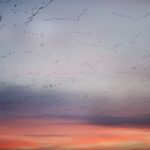A Skein of Geese
A Skein of Geese

The clocks have gone back, the nights are drawing in, and the trees are dressed in their glorious autumnal foliage. In our skies geese are flying in their distinctive wedge formations, the augury that Winter is coming. They are later this year due to the recent milder temperatures. This ‘V’ shape is known as a skein and it helps the flock fly faster as the front bird breaks the wall of air ahead, leaving a wake of swirling air behind which propels the next bird forward, so each bird gets some help from the one in front. The leader will then drop back and another goose will take its place
The UK hosts several types of Geese that come here in the Autumn to Winter from their breeding grounds in the far North, mostly within the Arctic Circle, flying here from Canada, Greenland, Iceland, Svalbard and the vast Russian tundra
Several species belong to the ‘Grey Goose’ group, the Anser genus. They are mostly large and predominantly grey-coloured birds. Brent, Barnacle and Canada Geese are part of the Branta genus (meaning black or burnt in Old Norse). There is also the Egyptian Goose which belongs to the Alopochen genus
All Geese are monogamous and mate for life
Greylag Goose – The largest and most common resident here with a population of approximately 140,000, augmented by 90,000 Winter arrivals from Iceland. The majority of the breeding pairs are found in Scotland
Pink-Footed Goose – The UK is an important destination for this bird, with over 360,000 spending their Winters here. Coming here from Greenland and Iceland and remaining until the late Spring. One of our smaller Geese, grey in colour with a pink bill and pink legs. Residing mostly in Scotland, the North West and East Anglia
White Fronted Goose – Lives up to its name! With a white front it comes here from Greenland and Russia. After breeding in the Arcitc and the Tundra, these birds arrive in the Autumn and stay until late March. Those that nest in Greenland spend the Winter in Ireland and the West Coast of Scotland, whilst the others overwinter here in the South. As UK is on the western most fringe of its wintering range their numbers vary greatly dependent upon weather conditions
Taiga Bean Goose – A rare visitor to UK. Darker and browner than other Geese in this group, with a dark head, long slim neck and black and orange bill. This Goose breeds on marshes around the Taiga, a forest of the sub-Arctic region
Tundra Bean Goose – Slightly smaller than the above Bean Goose and more commonly found. Sometimes confused with the Pink-Footed Goose. It breeds in the Russian Tundra and overwinters at coastal locations in Europe. Small numbers come here but they are erratic in their appearances. They are found in Eastern and South-Eastern England
Brent Goose – Two populations come to UK for the milder Winter, one with dark bellies, found in Eastern England, and those with pale bellies which overwinter in the North East and Ireland. The Dark Bellied variety comes from Russia and is only slightly bigger than a Mallard Duck. Whereas the Pale Bellied Brent breeds in the East Canadian Arctic and undertakes one of the longest migrations to winter in the North East and Ireland, feeding on eelgrass and crops in adjoining fields, once this is depleted they will disperse around the coastline and are even found grazing in parks in Dublin
Barnacle Goose – Arriving here from Svalbard and Greenland it overwinters in Scotland, Ireland and Northern England. There is now a small resident breeding population here in our parks and gravel pits. One of our smallest geese with a creamy-white face, a black neck, black-and-grey wings, and a white belly. Unlike the Canada goose, the Barnacle Goose has no brown on it at all
Canada Goose – Our most familiar goose but not actually native. We now have growing numbers of resident pairs in this country. Light brown in colour with a pale chest, black neck and face. First introduced from the Americas in the 17th Century, these birds are now a familiar sight both in parks and nature reserves across the country. They are our largest goose and often aren’t afraid to say hello!
Egyptian Goose – This very exotic looking goose was introduced from Africa in 18th Century. What they lack in size they make up for in personality, they can be loud and aggressive. Most commonly found in parks and on golf courses, with over 1,000 breeding pairs in the UK
Candida Hopkinson